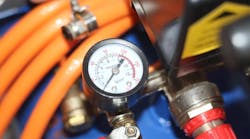Purposeful innovations are changing how compressed air systems are designed and managed. From integrated, intelligent performance monitoring solutions to advanced system engineering, today’s compressed air technologies are better equipped to support reliability, efficiency, performance, and sustainability goals.
System optimization
Using industrial sensors to track key metrics in compressed air systems facilitates performance optimization. The new Kaeser Measurement Technology (KMT) suite of intelligent sensors from Kaeser Compressors is designed to deliver real-time insights on a range of metrics including pressure, flow, energy, and air quality.
“You can set alarms for specific ‘do-not-cross’ pressure or dewpoint levels to protect production or control room ventilation in real time to prevent overheating. You can also use KMT to allocate compressed air costs to specific production lines according to their usage. These are just a few examples. The big point is to get actionable information – not just streams of data,” explains Neil Mehltretter, technical director at Kaeser Compressors.
CO2 and centrifugal solutions
For industrial refrigeration and large-capacity heat pumps, modern systems ease the transition to natural refrigerants. The transcritical HGX56 CO2 T from Danfoss BOCK is a 6-cylinder, semi-hermetic compressor designed for demanding conditions with natural refrigerant R744.
The HGX56 CO2 T “is ideal for use in high process applications like in the Food & Beverage industry as it helps produce water up to 90°C (194°F),” says Manuel Froschle, head of product management at Danfoss BOCK. “With a wide operating envelope and frequency range, one compressor is suitable for industrial heat pumps, commercial refrigeration, and district heating systems, and offers an efficient alternative to ammonia and synthetic refrigerants.”
A new oil-free centrifugal compressor with frictionless Aero-lift bearing technology from Copeland serves large chiller and heat recovery applications. It offers efficient, reliable performance, and is compatible with lower global warming potential (GWP) refrigerants.
Unlike other oil-free compressor solutions that rely on electromagnetic levitation bearings, Copeland’s Aero-lift bearing technology delivers oil-free simplicity without sensor and controls complexities, observes Mike Oakley, director of centrifugal solutions at Copeland. “The results are increased reliability and efficiency in full- and part-load conditions, robust performance in high-ambient environments, and increased operational continuity during power outages,” he adds.
For high-pressure applications where air quality is paramount, the P400HPR centrifugal air compressor from FS-Elliott provides an “economical and eco-conscious” solution. It is designed with more aero stages to achieve discharge pressures up to 250 psig and delivers ISO 8573-1 oil-free compressed air.
"The launch of the P400HPR shows our continued commitment to innovation, efficiency, and reliability,” says Michael Wik, director of product management at FS-Elliott. “The P400HPR was developed to optimize compressor performance in high-pressure applications, allowing us to set a new industry standard for aerodynamic design at high-discharge pressures.”
Rotary screw advancements
Efficiency and reliability, the two biggest demands of Hitachi Global Air Power’s big air customers, were answered with its Sullair TS Series rotary screw air compressors. “By re-imagining how air flows between the two compression chambers in our two-stage air end, we were able to achieve higher efficiency – actually best-in-class efficiency – with our patent-pending interstage cooler design,” explains Abram Valencic, senior manager air end engineering.
The TS Series and new two-stage air end are designed to be remanufactured for second and third lives, enhancing sustainability. The compressors’ over/under design enables a smaller footprint and uses fewer parts, improving serviceability.
The new EQ Series of oil-lubricated, direct-drive rotary screw air compressors from ELGi Compressors USA is available in multiple capacities from 25 to 30 hp. It comes in fixed or variable speed drive configurations with a totally enclosed, fan-cooled (TEFC) electric motor.
According to Robert Horneman, product manager at ELGi USA, “The new EQ Series air compressors are ideal for small to medium-sized operations that require high reliability. With a direct-drive design, they provide superior efficiency and a more compact form than traditional belt-driven models, all at a lower initial cost.”

